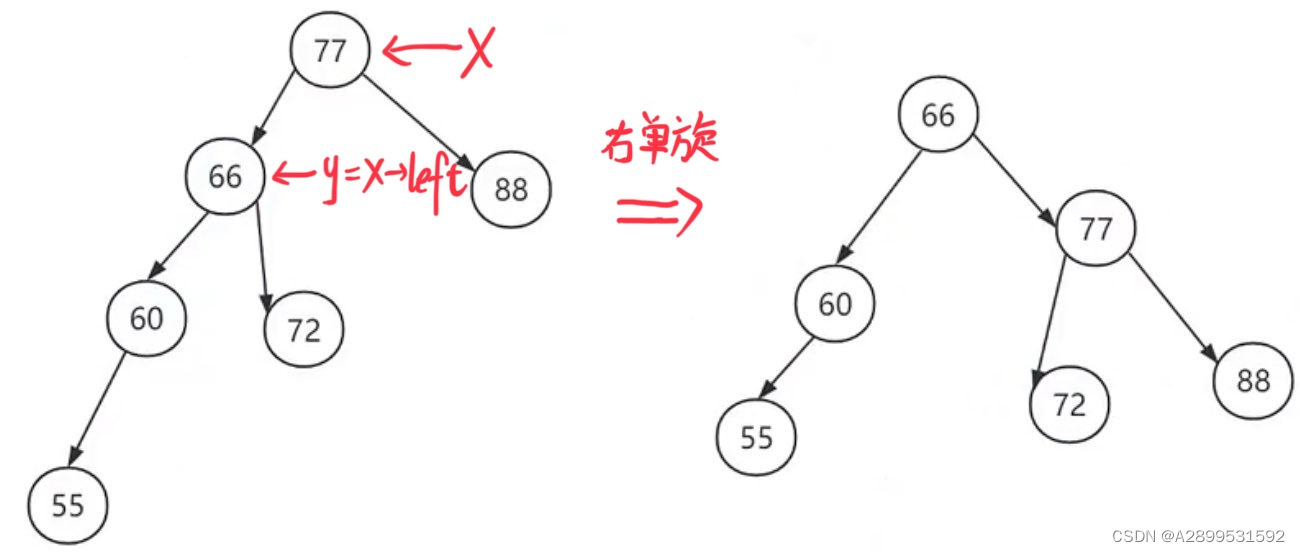一、为什么要有平衡?叉树
?叉搜索树?定程度上可以提?搜索效率,但是当原序列有序时,例如序列 A = {1,2,3,4,
5,6},构造?叉搜索树如图。依据此序列构造的?叉搜索树为右斜树,同时?叉树退化成单链表,搜索效率降低为 O(n)

?叉搜索树的查找效率取决于树的?度,因此保持树的?度最?,即可保证树的查找效率。同样
的序列 A,将其改为图示的?式存储,查找元素 6 时只需?较 3 次,查找效率提升?倍。

可以看出当节点数??定,保持树的左右两端保持平衡,树的查找效率最?。 这种左右?树的?度相差不超过 1 的树为平衡?叉树。
二、定义
平衡因子:一个节点的平衡因子是其左右子树的高度差
对BST加上限制:每个节点的平衡因子的绝对值不超过1-------->AVL树
官方定义:
AVL树有如下性质:
1、可以是空树。
2、假如不是空树,任何?个节点的左?树与右?树都是平衡?叉树,并且?度之差的绝对值不超
过 1。
平衡之意,如天平,即两边的分量?约相同。
如下图

该树就不是平衡?叉树,因为结点60的左右子树高度差绝对值超过了1

该图就是?颗平衡?叉树。
三、AVL树如何进行插入操作
最?失衡?树:在新插?的节点向上查找,以第?个平衡因?的绝对值超过 1 的节点为根的?树
称为最?不平衡?树。也就是说,?棵失衡的树,是有可能有多棵?树同时失衡的。?这个时候,我们
只要调整最?的不平衡?树,就能够将不平衡的树调整为平衡的树。
插入过程中,如果插入某个节点后失衡,对该树进行调整,使其恢复平衡
调整的过程就是旋转(ALV树的重点)
旋转基本操作:当前x节点失衡,以x节点为中心进行旋转
下图为旋转大致原理:

1.左单旋
上图即为左单旋操作
代码实现思路:
设x是失衡节点,y=x->right //y是x调整前的右子树

(1) 把y的左子树变成x的右子树
x->right=y->left;
(2) x变成y的左孩子
y->left=x;
(3) return y
2.右单旋

代码实现思路:
设x是失衡节点,y=x->left //y是x调整前的左孩子
(1) 把y的右孩子变成x的左孩子
x->left=y->right;
(2) x变成y的左孩子
y->right=x;
(3) return y
3.ALV树的查找,插入
1.查找:和BST一模一样
2.插入:插入一个数据x
(1)先按照BST的步骤进行插入
(2)算插入节点的所有祖先节点的平衡因子。----->高度差(get某个节点高度的函数)
节点x的高度x->h=max(x->left->h,x->right->h)+1;( h是高 )
节点的平衡因子:x的平衡因子为:x->left->h-x->right->h
(3)判断失衡:假设失衡节点x高度差为2
3.1)先看x->left和x->right谁高
3.2)再去高的子树里面去看根节点的哪边的子树高(去看x的孙节点的高度大小关系)
(4)调用对应的调整函数使树重新平衡
优先调整最小失衡子树
调整的类型有4种:假设最小失衡子树的根节点为A
LL:往A的左孩子的左子树中插入了一个节点,导致A的左子树比右子树高
调整策略:以A为中心右旋
LR:往A的左孩子的右子树中插入了一个节点,导致A的左子树比右子树高
(1)以A->left为中心进行左旋,转化为LL
(2)以A为中心右旋
RR:往A的右孩子的右子树中插入了一个节点,导致A的右子树比左子树高
以A为中心左旋
RL:往A的右孩子的左子树中插入了一个节点,导致A的右子树比左子树高
(1)以A->right为中心进行右旋,转化为RR
(2)以A为中心左旋
4.插入操作完整代码
#include <stdlib.h> #include <stdio.h> # include <string.h> /*AVL树代码*/ //AVL树的节点结构 typedef struct AVLNode{ int data;//数据域 struct AVLNode* left; struct AVLNode* right; int h;//该节点的高度 }AVLNode,*AVLtree; int max(int a,int b) { return a>b?a:b; } //得到树的高,不能直接写x->h,因为x可能是NULL int geth(AVLtree ro) { if(ro==NULL) { return 0; } else{ return ro->h; } } AVLtree initAVLtree(int k) { AVLNode* root=(AVLNode*)malloc(sizeof(AVLNode)); root->data=k; root->left=root->right=NULL; root->h=1; return root; } //四种失衡的调整函数 //LL-->以失衡节点x为中心,右旋 AVLtree LL_rotation(AVLtree x) { AVLNode* y=x->left; x->left=y->right; y->right=x; x->h=max(geth(x->left),geth(x->right))+1; y->h=max(geth(y->left),geth(y->right))+1; return y; } //RR-->以失衡节点x为中心,左旋 AVLtree RR_rotation(AVLtree x) { AVLNode* y=x->right; x->right=y->left; y->left=x; x->h=max(geth(x->left),geth(x->right))+1; y->h=max(geth(y->left),geth(y->right))+1; return y; } //LR--->以失衡节点x->left为中心,左旋.然后以失衡节点x为中心,右旋 AVLtree LR_rotation(AVLtree x) { x->left=RR_rotation(x->left); x= LL_rotation(x); return x; } //RL--->以失衡节点x->right为中心,右旋.然后以失衡节点x为中心,左旋 AVLtree RL_rotation(AVLtree x) { x->right=LL_rotation(x->right); x= RR_rotation(x); return x; } AVLtree insert_AVL(AVLtree root,int k) { if(root==NULL) { AVLNode* s=(AVLNode*)malloc(sizeof(AVLNode)); s->data=k; s->left=s->right=NULL; s->h=1; return s; } else if(k<root->data) { root->left=insert_AVL(root->left,k); //判断root是否失衡:LL LR if(geth(root->left)-geth(root->right)>1) { AVLNode* l=root->left; if(k < l->data )//或者 if(geth(l->left)>geth(l->right)) {//LL root=LL_rotation(root); } else {//LR root=LR_rotation(root); } } } else if(k>root->data) { root->right =insert_AVL(root->right ,k); //判断root是否失衡:RR RL if(geth(root->right )-geth(root->left )>1) { AVLNode* r=root->right ; if(k > r->data ) {//RR root=RR_rotation(root); } else {//Rl root=RL_rotation(root); } } } root->h=max(geth(root->left),geth(root->right))+1; return root; } void inorder(AVLtree root) { if(root!=NULL) { inorder(root->left ); printf("%d %d ",root->data,root->h); inorder(root->right); } } int main() { int n; int a[105]; scanf("%d",&n); for(int i=1;i<=n;i++) { scanf("%d",&a[i]); } AVLtree root=initAVLtree(a[1]); for(int i=2;i<=n;i++) { root=insert_AVL(root,a[i]); } inorder(root); return 0; }
四、AVL树的删除
假设在一棵AVL树中删除一个数据k
(1)执行BST的删除操作
BST删除:k在节点中
1.1)x度为0/1:直接删除节点,x唯一的孩子顶替x的位置
1.2)x度为2:找x的中序遍历前驱节点或后继节点y,x->data=y->data,问题转化成删除y节点
中序遍历前驱节点:x左子树中最靠右的节点(左子树中数据值最大)
中序遍历后继节点:x右子树中最靠左的节点(右子树中数据值最小)
(2)判断失衡:假设在x的子树中删除了一个节点,失衡节点是节点
当在x的左子树中删除一个节点时,左子树高度减一,导致失衡。看成:右子树一棵树也陪着左子树删了一个节点,但是又插入回来了,此时就变成插入导致的失衡了。
在x节点的一边的子树中删除了一个节点,就等价于在其另一边子树插入了一个节点导致的失衡--------->删除的失衡类型及调整方式和插入的失衡类型及调整方式一摸一样。
左删除 相当于 右边插入:RR 、RL
右删除 相当于 左边插入:LL 、LR
如下为例子:

可以看出删掉节点9以后该树能恢复平衡,因此该树等价于删掉节点9后再插入节点9,即LL型,以节点20为中心右旋即可恢复平衡。
特殊例子:

删掉节点30时,节点20的左孩子的左子树和右子树的节点都需要删掉才能使树平衡,这时LL和LR都行(推荐用LL,步骤比较少),可以自己试试看两种方法都能使该树平衡。
代码:
AVLNode* find(AVLNode* l)//查找l的左子树的最右节点 { while(l->right!=NULL) { l=l->right; } return l; } //在以root为根的树中删除k AVLtree AVL_de(AVLtree root,int k) { if(root==NULL) { return NULL; } if(k<root->data) { root->left=AVL_de(root->left,k); //判断root失衡 if( geth(root->right) - geth(root->left) >1) {//RR RL AVLNode* r=root->right; if( geth(r->right) >= geth(r->left) ) {//RR root=RR_rotation(root); } else {//RL root=RL_rotation(root); } } } else if(k>root->data) { root->right =AVL_de(root->right ,k); // LL LR if( geth(root->left) - geth(root->right) >1 ) {//LL LR AVLNode* l=root->left; if( geth(l->left) >= geth(l->right) ) { root=LL_rotation(root); } else{ root=LR_rotation(root); } } } else { if(root->left!=NULL&&root->right!=NULL) { AVLNode* maxNode=find(root->left); root->data=maxNode->data; root->left=AVL_de(root->left,maxNode->data); if( geth(root->right) - geth(root->left) >1) {//RR RL AVLNode* r=root->right; if( geth(r->right) >= geth(r->left) ) {//RR root=RR_rotation(root); } else {//RL root=RL_rotation(root); } } } else { AVLNode* x=root; if(root->left!=NULL) { root=root->left; } else { root=root->right; } free(x); x=NULL; return root; } } root->h=max(geth(root->left),geth(root->right))+1; return root; }
五、AVL树插入和删除操作的完整代码
#include <stdlib.h> #include <stdio.h> # include <string.h> /*AVL树代码*/ //AVL树的节点结构 typedef struct AVLNode{ int data;数据域 struct AVLNode* left; struct AVLNode* right; int h;//该节点的高度 }AVLNode,*AVLtree; int max(int a,int b) { return a>b?a:b; } //得到树的高,不能直接写x->h,因为x可能是NULL int geth(AVLtree ro) { if(ro==NULL) { return 0; } else{ return ro->h; } } AVLtree initAVLtree(int k) { AVLNode* root=(AVLNode*)malloc(sizeof(AVLNode)); // root->data=k; root->left=root->right=NULL; root->h=1; return root; } //四种失衡的调整函数 //LL-->以失衡节点x为中心,右旋 AVLtree LL_rotation(AVLtree x) { AVLNode* y=x->left; x->left=y->right; y->right=x; x->h=max(geth(x->left),geth(x->right))+1; y->h=max(geth(y->left),geth(y->right))+1; return y; } //RR-->以失衡节点x为中心,左旋 AVLtree RR_rotation(AVLtree x) { AVLNode* y=x->right; x->right=y->left; y->left=x; x->h=max(geth(x->left),geth(x->right))+1; y->h=max(geth(y->left),geth(y->right))+1; return y; } //LR--->以失衡节点x->left为中心,左旋.然后以失衡节点x为中心,右旋 AVLtree LR_rotation(AVLtree x) { x->left=RR_rotation(x->left); x= LL_rotation(x); return x; } //RL--->以失衡节点x->right为中心,右旋.然后以失衡节点x为中心,左旋 AVLtree RL_rotation(AVLtree x) { x->right=LL_rotation(x->right); x= RR_rotation(x); return x; } AVLtree insert_AVL(AVLtree root,int k) { if(root==NULL) { AVLNode* s=(AVLNode*)malloc(sizeof(AVLNode)); s->data=k; s->left=s->right=NULL; s->h=1; return s; } else if(k<root->data) { root->left=insert_AVL(root->left,k); //判断root是否失衡:LL LR if(geth(root->left)-geth(root->right)>1) { AVLNode* l=root->left; if(geth(l->left)>geth(l->right)) //或者 if(k < l->data ) {//LL root=LL_rotation(root); } else {//LR root=LR_rotation(root); } } } else if(k>root->data) { root->right =insert_AVL(root->right ,k); //判断root是否失衡:RR RL if(geth(root->right )-geth(root->left )>1) { AVLNode* r=root->right ; if(geth(r->right )>geth(r->left)) //if(k > r->data ) {//RR root=RR_rotation(root); } else {//Rl root=RL_rotation(root); } } } // root->h=max(root->left->h,root->right->h)+1;//bug root->h=max(geth(root->left),geth(root->right))+1; return root; } //----------------------------------------------------------------- AVLNode* find(AVLNode* l)//查找l的左子树的最右节点 { while(l->right!=NULL) { l=l->right; } return l; } //在以root为根的树中删除k AVLtree AVL_de(AVLtree root,int k) { if(root==NULL) { return NULL; } if(k<root->data) { root->left=AVL_de(root->left,k); //判断root失衡 if( geth(root->right) - geth(root->left) >1) {//RR RL AVLNode* r=root->right; if( geth(r->right) >= geth(r->left) ) {//RR root=RR_rotation(root); } else {//RL root=RL_rotation(root); } } } else if(k>root->data) { root->right =AVL_de(root->right ,k); // LL LR if( geth(root->left) - geth(root->right) >1 ) {//LL LR AVLNode* l=root->left; if( geth(l->left) >= geth(l->right) ) { root=LL_rotation(root); } else{ root=LR_rotation(root); } } } else { if(root->left!=NULL&&root->right!=NULL) { AVLNode* maxNode=find(root->left); root->data=maxNode->data; root->left=AVL_de(root->left,maxNode->data); if( geth(root->right) - geth(root->left) >1) {//RR RL AVLNode* r=root->right; if( geth(r->right) >= geth(r->left) ) {//RR root=RR_rotation(root); } else {//RL root=RL_rotation(root); } } } else { AVLNode* x=root; if(root->left!=NULL) { root=root->left; } else { root=root->right; } free(x); x=NULL; return root; } } root->h=max(geth(root->left),geth(root->right))+1; return root; } //--------------------------------------------------------- void inorder(AVLtree root) { if(root!=NULL) { inorder(root->left ); printf("%d %d ",root->data,root->h); inorder(root->right); } } int main() { int n; int a[105]; scanf("%d",&n); for(int i=1;i<=n;i++) { scanf("%d",&a[i]); } AVLtree root=initAVLtree(a[1]); for(int i=2;i<=n;i++) { root=insert_AVL(root,a[i]); } inorder(root); int k; scanf("%d",&k); root=AVL_de(root,k); inorder(root); return 0; }